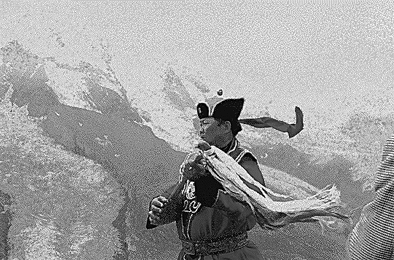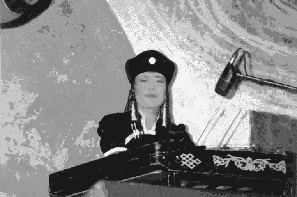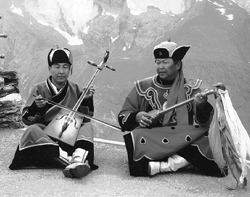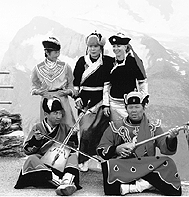|
- Catalog (in stock)
- Back-Catalog
- Mail Order
- Online Order
- Sounds
- Instruments
- Projects
- History Face
- ten years 87-97
- Review Face
- our friends
- Albis Face
- Albis - Photos
- Albis Work
- Links
- Home
- Contact
- Profil YouTube
- Overton Network
P & C December 1998
- Face Music / Albi
- last update 03-2016
|
1. Khoojiimaa - 2:02
2. Khögön-Khaan uuliin magtaal - 6:57
3. Üülen bor - 1:54
4. Bamboo - solo - 1:17
5. Tsenkherlen kharagdakh Uuls - Khonin joroo mori - 1:44
6. Algirmaa - 3:05
7. Baruun mongoliin mörgöliin aya - 1:56
8. Shar khad - 2:55
9. Khonindoo yavaad - 2:03
10. Khonkhon tsetseg - 1:39
11. Morin khuur - solo - 2:07
12. Junden Göögöö - 3:17
13. Khoid goidiin ayalguu - 2:34
14. Ardiin Ayalguu - solo - 2:40
15. Arkhinii shog - 2:35
16. Genghis khaanii magtaal - 6:49
17. Khan-Khentiin magtaal - 4:28
18. Sukhee gol - 1:33
19. Uliastai gol - 1:41
20. Tiijüü khot - 2:27
21. Taliin tavan tolgoi - 1:26
22. Gunan khar - 2:02
23. Zambaga yagaan tsetseg - 1:36
24. Mongol ardiin ayalguu - 2:50
25. Gangiin nogoo - 3:54
26. Tokhoi zandan mod - 2:32
27. Sumya noyon - 2:02
Songs
1. Khoojiimaa
- Yavgaan: voc, tömör hel khuur, Amarjargal: morin khuur, Selenge: yoochin - short song (bogino duu)
|
A woman called Khoojiimaa is looking at the steppe and dreaming of love, everyday life and her happiness.
|
2. Khögön-Khaan uuliin magtaal
- Yavgaan: voc, bells, höömij, Amarjargal: morin khuur - (magtaal)
|
This is a praise song for the Mountain (uul) Khögön-Khan.
|
3. Üülen bor
- Amarjargal: morin khuur, Selenge: yoochin - short song (bogino duu)
|
This is a song for the cloudy-grey-brown one (üülen bor – meaning a horse whose fur is of a cloudy grey and brown colour). It is a good horse and everyone likes it.
|
- Mongols don't give their horses names as we do, but call them by the hue of their fur.
|
4. Bamboo
- Yavgaan: hulsan hel khuur - jew's harp made of bamboo - traditional melody - solo
|
5. Tsenkherlen kharagdakh Uuls - Khonin joroo mori
- Yavgaan: tömör hel khuur, Amarjargal: morin khuur, Selenge: yoochin - two short songs (bogino duu)
|
- The silvery blue mountains on the horizon. It is sung of their radiation and their beauty.
|
- The leisurely tripping horse (khonin joroo mori). The Mongols love horses with such a character and they always hope that their life partner will have just such a character.
|
6. Algirmaa
- Amarjargal: morin khuur, Selenge: yoochin - short song (bogino duu)
|
After Algirmaa's husband had been called up for military service, his parents chased her from their house. Now she is waiting patiently for her husband's return. Finally he comes back and takes his wife home again.
|
7. Baruun mongoliin mörgöliin aya
- Yavgaan: aman tsuur, Amarjargal: morin khuur, Selenge: yoochin - melody from Western Mongolia
|
This is a song about Western Mongolia. It praises the beautiful country, its wealth, its friendly inhabitants and the many horses.
|
8. Shar khad
Yavgaan: voc, Amarjargal: morin khuur, Selenge: yoochin - short song (bogino duu)
|
Yellow rock (shar khad). This song praises the mother, whose love, affection, devotion and work is esteemed very much.
|
9. Khonindoo yavaad
- Yavgaan: voc, Amarjargal: morin khuur, Selenge: yoochin - traditional song of the Darkhat (a Mongolian tribe that lives in the North, near the border of Tuva) with satirical contents.
|
A shepherd (khonindoo yavaad) works very hard for the benefit of his family. Every day he tends the big herd and takes care of the lambs. But his mother isn't satisfied and thinks that her only son should work much more.
|
10. Khonkhon tsetseg
- Yavgaan: voc, Amarjargal: morin khuur, Selenge: yoochin - short song (bogino duu)
|
Snowdrop (khokhon). This is a song about the awakening nature and the approaching spring when the snowdrops begin to bloom, the first rain falls and the whole world blossoms again.
|
11. Morin khuur
- Amarjargal: morin khuur - traditional melody - solo
|
12. Junden Göögöö
- Yavgaan: aman tsuur, Amarjargal: morin khuur, Selenge: yoochin - short song (bogino duu)
|
This is the legend of a young and handsome man of the name of Junden Göögöö. He was living in the middle of the 19th century in the region of the river Khalkh (Dornod-Aimak). He was a dexterous wrestler and archer as well as a good singer. He wore his hair long like a woman and he had a dark skin. Up to date, whenever Mongolian girls talk about a young handsome man, they call him Junden Göögöö.
|
13. Khoid goidiin ayalguu
- Yavgaan: hulsan hel khuur, höömij - solo - traditional melody of Western Mongolia
|
14. Ardiin Ayalguu
- Amarjargal: morin khuur - solo - traditional folk melody
|
15. Arkhinii shog
- Yavgaan: voc, tömör hel khuur, höömij, Amarjargal: morin khuur - short song (bogino duu)
|
Vodka song (arkhinii shog). Nobody comes to harm by drinking a little bit, but when one is drinking too much everything gets out of control.
|
16. Genghis khaanii magtaal
- Yavgaan: voc, tömör hel khuur, höömij, khun tovshuur, khengereg (kettledrum - bass drum), Amarjargal: morin khuur - (magtaal)
|
Praise song for "Genghis Khan".
|
17. Khan-Khentiin magtaal
- Yavgaan: voc, hel khuur, Amarjargal: morin khuur - (magtaal)
|
Praise song for the mountain Khan-Khentiin.
|
18. Sukhee gol
- Yavgaan: voc, tömör hel khuur, khun tovshuur, Amarjargal: morin khuur - short song (bogino duu)
|
Praise song for the river Sukhee.
|
19. Uliastai gol
- Yavgaan: voc, Amarjargal: morin khuur, Selenge: yoochin - short song (bogino duu)
|
A girl is standing on the bank of the river Uliastai and is reflecting on how to cross it, in order to reach her lover as soon as possible.
|
20. Tiijüü khot
- Selenge: yoochin - solo - short song (bogino duu)
|
A musician is performing in a bar in the centre of the town (khot) called Tiijüü. She is happy and enjoys having the attention of the audience. But there is a drunken man, who often disturbs her, addressing her and asking her to have a drink with him. She doesn't like that and is very annoyed.
|
21. Taliin tavan tolgoi
Yavgaan: tömör hel khuur, Amarjargal: morin khuur, Selenge: yoochin - short song (bogino duu)
|
Head mountains (tolgoi). The wife is waiting for the return of her husband, who is actually rendering five years of military service.
|
22. Gunan khar
- Amarjargal: morin khuur, Selenge: yoochin - short song (bogino duu)
|
Praise song for a dark horse (gunan khar). It's a good horse, this black one.
|
23. Zambaga yagaan tsetseg
- Yavgaan: voc, Amarjargal: morin khuur, Selenge: yoochin - short song (bogino duu)
|
Magnolia flower (zambaga yagaan tsetseg). This is a song about the magnolia tree with its rose flowers.
|
24. Mongol ardiin ayalguu
Selenge: yoochin - solo - traditional melody
|
25. Gangiin nogoo
- Amarjargal: morin khuur - solo - short song (bogino duu)
|
This is a song about the sappy grass (nogoo) growing on the river Gangiin.
|
26. Tokhoi zandan mod
- Yavgaan: voc, Amarjargal: morin khuur, Selenge: yoochin - short song (bogino duu)
|
This is a song about the tree of precious wood (zandan mod).
|
27. Sumya noyon
- Yavgaan: voc, Amarjargal: morin khuur, Selenge: yoochin - short song (bogino duu)
|
King Sumya's wife wavers between her love for the king and that for a Lama (monk) and she just cannot decide for either of them. The king loves her and, after all, wants her to take a decision and stop with these interludes.
|
- map sketch Mongolia
Instruments
The nomad shepherds in Mongolia, like other nomads from central Asia, use to play string- and wind instruments.
Percussion instruments though, were only used in connection with Shamanism and Buddhism, the origins of which are to be found in the Tibetan Lamaism, as well as with the "Tsam Dance", which was performed in Mongolia for the first time in the 8th century.
|
- Hel khuur (Jew's harp)
|
|
Nowadays, a Jew's harp is made of brass or steel, but in earlier days it was made of wood or bamboo. A spring, acting as a vibrator, is fitted into a horseshoe-shaped metal holder and is called 'tongue'. The player places the long part of the instrument close to his mouth, touching it with his front teeth and manipulating the tongue with his right hand. The pitch can be varied by changing the shape of the mouth cavity, which at the same time acts as a resonance chamber.
|
|
- Tsuur (wind instrument)
|
|
The tsuur is a traditional Mongolian wind instrument (flute) made of "uliangar" wood (bur chervil - umbellifer). Melody and sound resemble the sound of the waterfall of the River Jeven. The "aman tsuur" made by the Altai-Uriankhai tribes are the most popular ones and produce the best sound.
|
|
- Khun tovshuur - Tovshuur (string instrument)
|
|
The khun tovshuur is a two-stringed instrument similar to the lutes of Tuva, Altai or Kazakhstan. The body and the neck are carved from cedar wood and the body is often coated with the leather of wild animals, camels or goats. The strings are plaited with the horsetail hair and tuned in the interval of a fourth.
|
|
The West Mongols use this lute to accompany the "tuuli" (heroic-epic myths) and "magtaal" (praise songs).
|
|
- Morin khuur (string instrument - horse-head-violin)
|
|
The morin khuur is a typical Mongolian two-stringed instrument. The body and the neck are carved from wood. The end of the neck has the form of a horse-head and the sound is similar to that of a violin or a cello. The strings are made of tried deer or mountain sheep sinews. It is played with a bow made of willow, stringed with horsetail hair and coated with larch or cedar wood resin.
|
|
This instrument is used to play polyphonic melodies, because with one stroke of the bow the melody and drone-strings can be played at the same time. The morin khuur is the most widespread instrument in Mongolia, and is played during celebrations, rituals and many other occasions, as well as an accompaniment for dances or songs. Even the sound and noises of a horse herd are imitated on the morin khuur.
|
|
People say that it is connected with a handsome man. It is also played when a ewe doesn't want to suckle her lamb.
There is a legend about the origin of this instrument. A Mongol missed his dead horse so much that he used its head, its bones and its hair to build an instrument on which he started to play the familiar noises of his beloved horse.
|
|
- Yoochin (string instrument)
|
|
Box zither - dulcimer with 13 double-wire strings. The strings are struck with two wooden sticks, so-called little wooden hammers (comparable with the santur of the Persians). It has a black wooden soundboard richly decorated with ornaments.
The instrument was only familiar to townspeople and first of all only they played it. |
Vocal music
|
- Urtyin duu - long song, |
|
melismatic and richly ornamented, with a slow tempo, long melodic lines, wide intervals and no fixed rhythm.
|
|
It is sung in verses, without a regular refrain and with a full voice in the highest register. The melody has a coat which covers over three octaves. This requires a strict observance of the breathing rules. The breathing is actually free, but the singer has to keep to the strict rules of performance, making only the abolutely necessary breathing breaks without interrupting the melodic ornaments. The richer the voice is and the longer the singer can hold it, the more internsive is the attention paid by the auditors and the more his performance is appreciated.
|
|
People usually practise these long songs while being alone in the open steppe and riding along slowly. The repertory is an expression of the liberty and the vastness of the Mongolian steppe and is used to accompany the rites of the seasonal cycles and the ceremonies of everyday life. Long songs are an integral part of the celebrations held in the round tents and they must be sung after the strict rules of performance. |
|
There are three categories of long songs: |
|
- The shortened ones have short verses, refrains and melodic courses full of leaps and bounds. |
|
- The extended ones with uninterrupted flowing melodies, richly ornamented, containing long passages in falsetto. |
|
- The usual ones are shorter, less ornamented and without falsetto.
|
|
- Bogino duu - short song |
|
strophic, syllabic, rhythmically tied, sung without ornaments.
|
|
Short songs are never used at celebrations, since they are spontaneously improvised and rather satirical. They are often lyrical tales about love, about the everyday life and about animals, especially horses.
|
|
- Tuuli - heroic-epic myths
|
|
Mongolian epics report about fierce fights between the good and evil powers in a highly qualified literary poetry.
The recital of epics was always bound to rituals and it was believed to have magical power. The recitation should have a favourable influence on natural spirits as well as the power to expulse evil spirits. Generally, the epics were sung inside the round felt tents of the shepherds, during the period of their search for the winter quarters, before the hunt or a battle, and against infertility or disease.
|
|
- Magtaal - praising songs
|
|
Magtaal are sung in honour of the gods of Lamaism and the nature spirits, heralds or particular animals. Epic texts also contain praise songs for the mountains, the rivers and nature in general. This is an ancient tradition still practised up to date by the tribes in the region of Mongol-Altai in Western Mongolia.
|
|
- Khöömij - overtone singing
|
|
The performance of overtone singing takes usually place during social events such as eating or drinking parties. |
|
The Mongols call their overtone singing höömij (= throat, pharynx). The singer creates a constant pitched fundamental considered as a drone, and at the same time modulates the selected overtones to create a formantic melody from harmonics. |
|
Several techniques are known, depending on the vocal source and the place of resonance: kharkhiraa = lung, khamriin = nose, tövönkhiin = throat and bagalzuuriin = pharynx. Overtone singers form and vary sound and timbre with their mouth, teeth, tongue, throat, nose and lips. They always form two distinct tones simultaneously sustaining the fundamental pitch. |
|
Overtone singing can also be heard from Turkic-speaking tribes in disparate parts of central Asia. The Bashkir musicians from the Ural Mountains call their style of overtone singing uzlyau; the Khakass call it khai, the Altai call it koomoi and the Tuvinians khoomei. |
|
Up to date, overtone singing is a common feature of Siberian peoples as well as the Kazakhs and Mongolian tribes. Overtone or throat singing is a special technique in which a single vocalist produces two distinct tones simultaneously. One tone is a low, sustained fundamental pitch (a kind of drone) and the second is a series of flutelike harmonics, which resonate high above this drone. Who masters this singing technique may even make the overtone sound louder then the fundamental pitch, so the drone is not audible anymore. A different technique often used by overtone singers combines a normal glottal pitch with the low frequency, pulse-like vibration known as vocal fry. The Turkic tribes in the Altai use to sing their texts in such a low vocal fry register of about 25-20 Hz). |

Yavgaan, höömij, khun tovshuur
The folk and song ensemble Temuzhin was established in 1990 by the "Khan-Altai" Foundation.
Temuzhin was the boyhood name of the great "Genghis Khan", who was not only a warrior and conqueror, but also a lover of the fine arts which he furthered a great deal at his court.
- More songs and information about Mongolia see:
Duo Temuzhin - "Altai-Khangain-Ayalguu" FM 50023
and Ensemble Ardiin Ayalguu - "Solongo" FM 50024
Review:
- published by Green Man Review
- published by Ethnotempos
- published by Main-Echo - 1998
- published by Magazine i Fiati - Italy - 1999
- published by neue musikzeitung 2002

Selenge - yoochin
 
Amarjargal, morin khuur - Yavgaan, höömij, khun tovshuur - Ensemble Temuzhin
|
